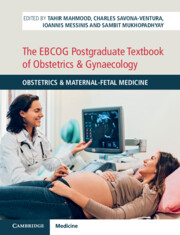Book contents
- The EBCOG Postgraduate Textbook of Obstetrics & Gynaecology
- The EBCOG Postgraduate Textbook of Obstetrics & Gynaecology
- Copyright page
- Dedication
- Contents
- Contributors
- Preface
- Section 1 Basic Sciences in Obstetrics
- Section 2 Early Pregnancy Problems
- Section 3 Fetal Medicine
- Section 4 Maternal Medicine
- Section 5 Intrapartum Care
- Section 6 Neonatal Problems
- Section 7 Placenta
- Section 8 Public Health Issues in Obstetrics
- Chapter 65 Social and Cultural Aspects Affecting Pregnancy Outcomes in Migrant Populations
- Chapter 66 Immunization in Pregnancy
- Chapter 67 Saving Lives, Improving Mothers’ Care
- Chapter 68 Clinical Governance in Obstetric Practice
- Chapter 69 Ethical Issues and Conflict in Maternal-Fetal Medicine and Obstetrics
- Chapter 70 Legal Considerations in Obstetric Practice
- Chapter 71 Research and Audit in Obstetric Practice
- Section 9 Co-Morbidities during Pregnancy
- Index
- Plate Section (PDF Only)
- References
Chapter 70 - Legal Considerations in Obstetric Practice
from Section 8 - Public Health Issues in Obstetrics
Published online by Cambridge University Press: 20 November 2021
- The EBCOG Postgraduate Textbook of Obstetrics & Gynaecology
- The EBCOG Postgraduate Textbook of Obstetrics & Gynaecology
- Copyright page
- Dedication
- Contents
- Contributors
- Preface
- Section 1 Basic Sciences in Obstetrics
- Section 2 Early Pregnancy Problems
- Section 3 Fetal Medicine
- Section 4 Maternal Medicine
- Section 5 Intrapartum Care
- Section 6 Neonatal Problems
- Section 7 Placenta
- Section 8 Public Health Issues in Obstetrics
- Chapter 65 Social and Cultural Aspects Affecting Pregnancy Outcomes in Migrant Populations
- Chapter 66 Immunization in Pregnancy
- Chapter 67 Saving Lives, Improving Mothers’ Care
- Chapter 68 Clinical Governance in Obstetric Practice
- Chapter 69 Ethical Issues and Conflict in Maternal-Fetal Medicine and Obstetrics
- Chapter 70 Legal Considerations in Obstetric Practice
- Chapter 71 Research and Audit in Obstetric Practice
- Section 9 Co-Morbidities during Pregnancy
- Index
- Plate Section (PDF Only)
- References
Summary
The popular connotation that obstetrics is the hardest hit by the suing epidemic is often true. The UK’s £1.7 billion payout for obstetric negligence in 2016/17 also reflects that much of the ‘epidemic’ does in fact involve avoidable mishaps [1]. Furthermore, it is not infrequent for the perception of malpractice to underlie legal litigation and this often implies poor communication between obstetrician and patient. Legal confrontation is not automatically synonymous with medical injury or medical error. In a series of 1452 closed malpractice claims, 3% of patients had no verifiable medical injuries [2]. Why patients sue obstetricians is a question very worth asking. One fact is certain: most obstetricians need to raise constructive awareness (as distinct from defensive practice) of the legal aspects of their practice.
- Type
- Chapter
- Information
- The EBCOG Postgraduate Textbook of Obstetrics & GynaecologyObstetrics & Maternal-Fetal Medicine, pp. 569 - 575Publisher: Cambridge University PressPrint publication year: 2021

